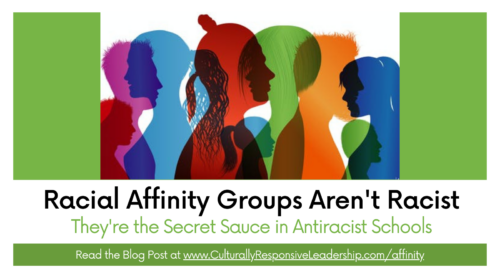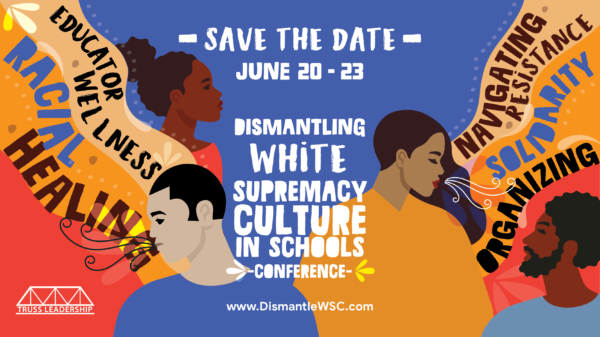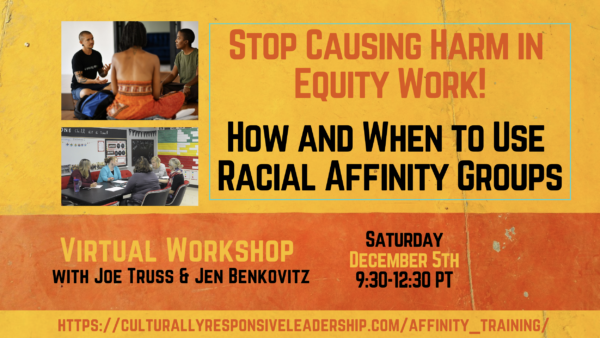Racial Affinity Groups Aren’t Racist – They are the Secret Sauce in Antiracist Schools
Many folks think that racial affinity groups are racist or separatist. They actually are a space for healing, deeper learning, and reflection. If you are prepared to avoid the pitfalls, racial affinity groups can help you dismantle white supremacy culture and build antiracist schools. See how you can stop causing harm to BIPOC through the intentional use of racial affinity space.
Check out Next Conference in June 2022
This blog post was co-written with Jen Benkovitz, my colleague and a leadership coach, at the Leadership Collaborative.
2 STORIES OF RACIAL EQUITY WORK GOING WRONG
Jen’s Story: Years ago, I participated in a workshop that was geared towards helping leaders center racial equity when designing and facilitating professional development. After brief introductions, the facilitators set the stage for our time together by showing a short video that included BIPOC high school students sharing examples of racial discrimination that they experienced in their school. Afterward, we engaged in a “Chalk Talk” protocol to share reflections including our emotions and personal connections. I don’t remember much about the debrief that followed except for the very first reflection shared by one of three Black males in the room. Tears in his eyes, he took a deep breath before saying, “This was so overwhelming for me. It’s honestly too much.” He then recounted his experiences as a student, as well as what he witnessed on a daily basis as a high school administrator. There is A LOT to unpack here, but more than anything else, this memory continues to remind me how important it is to make time and space for racial affinity work, and to be intentional about when and how to hold that space so that we stop harming and re-traumatizing BIPOC participants.
Joe’s Story: I was sitting in a zoom meeting and the facilitator plays a video of Christian Cooper being terrorized by Amy Cooper in Central Park. I can get down with that. I am thinking Ok, we are going somewhere with this. The facilitator says, “Now we are going to discuss this with a breakout group. Please share what’s coming up for you.” I arrived in a virtual breakout room. All white folks. And me. C’mon now. I think this isn’t going to end well. They look at me. I’m like, Hell no, I ain’t sharing first. I say, “Go head, share.” Homegirl, white woman, shares, and in second, the white tears come. Honestly, I don’t hear anything. I just see tears and her mouth moving. I scan the facial features of the other people. Hoping someone is bothered at least. No one. I look back at homegirl crying. I am not here for this. I jump in after she speaks and say, “Look, I’m going to leave this space for y’all to work out whatever y’all need, but this isn’t for me. I gotta go.” Damn, how fast can I find the leave breakout room or better yet, the leave meeting button. That was not a space for BIPOC.
WHAT ARE RACIAL AFFINITY GROUPS?
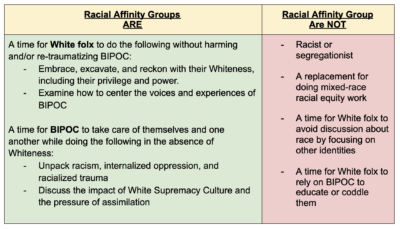
WHY DO WE NEED RACIAL AFFINITY GROUPS?
For BIPOC: Time to unpack internalized oppression and racialized trauma
Let’s keep it 100. Just because we are brown doesn’t mean we are immune to white supremacy culture and the pressures of assimilation. If we made it this far, we have been at least somewhat co-opted. Some of us have internalized the messages of racial hierarchy, creating self-hatred. BIPOC have to unlearn messages and return to loving ourselves. This particular work is very hard to do in front of white folks. First, it’s hard to believe that you can understand it. Second, it’s embarrassing to admit. Third, us admitting this might give you the opportunity to shirk your responsibility for causing racial trauma and abuse. Racial affinity allows for a safe place to talk about internalized oppression.
For BIPOC: Space to talk about BIPOC needs from the larger, white group
Many (All) times spaces are built for white comfort and structured to maintain white supremacy. This leaves BIPOC literally on the margins and at the bottom. Even when we have time to set norms “together,” if we are a numerical minority, our needs are drowned out in whiteness. Affinity space can be used for BIPOC to assess their needs from the group and share them with collective power. This might be a list of “asks” or better yet “demands” from the space, organization, or specifically from white colleagues. You might even give BIPOC space to write norms that center their liberation in the organization. This can’t be done as effectively in mixed race, because of the white gaze, white fragility, and white rage. It gobbles us up, almost every time.
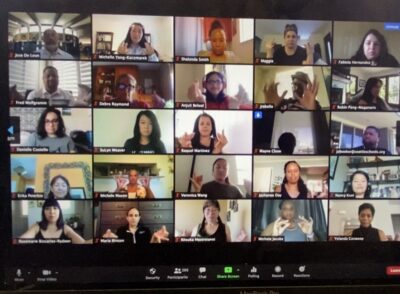
For White People: Structure needed to critically and authentically examine our Whiteness
I know you’re thinking, “But working together in a separate group to discuss race is segregationist.” Let’s be honest… we regularly get together in all White groups to chat about our families, hobbies and vacations, so why not get together with other White people to talk about race and racism? We all have learning to do (and undo), emotions to process (White fragility and rage), and questions to ask. Instead of relying on BIPOC to coddle our feelings and educate us about race and racism, we need our own time and space together to grapple with our Whiteness and own the impact of our actions (despite our intentions). As Dr. Craig Elliot II puts it, “We [White people] cannot be effective in partnering for change if we stay in our heads; we need to be courageous to engage, be vulnerable, feel, and be imperfect…” (2016)
For White People: Provides us with the time and space to commit to actionable change
An essential first step is for us to center BIPOC voices by ceding our power, privilege and comfort. This means that when we do have opportunities to engage in conversations with BIPOC, it is time for us to stop talking and start listening so that our actions can be informed by their voices and experiences, rather than by our misguided, white-centered assumptions. We need to literally practice what it looks and sounds like to disrupt our internalized dominance and superiority and to challenge systems, practices and policies that perpetuate and reinforce dominant norms and practices. This includes learning about, discussing and role playing “interruption” strategies. We can only achieve racial equity and justice if we relentlessly hold one another accountable for collectively transferring our learning and commitments into action.
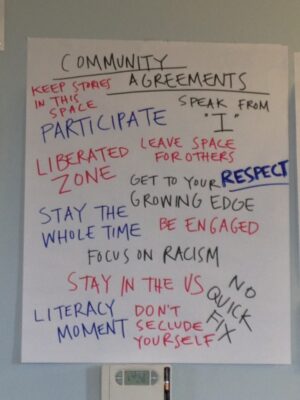
6 PITFALLS OF LEADING RACIAL AFFINITY GROUPS
- Rushing to “reunite” the groups and/or doing so in a way that centers Whiteness
- Keeping all BIPOC together all the time, instead of breaking into cultural caucuses
- Including people who are resistant to equity work
- Not using/adhering to community agreements or norms
- Emphasis on “teaching” vs prioritizing time for critical inquiry, reflection, and dialogue
- Not committing to actionable next steps
CONCLUSIONS – FACILITATOR TIPS
Joe’s Advice-As a facilitator, I think the best advice I would give is to just do the damn thing. That isn’t to say don’t plan or prepare. But schedule it and start planning. Be sure that folks know why you are using the tool of racial affinity space and what the goals are. They can be loose. Everything doesn’t have a measurable goal. And can you really measure the safety and wellness of BIPOC? Maybe, but the point is to center BIPOC in the process and to push on white folks to work through their shit. If you can find a way to communicate that, you are halfway there. Finally, it helps to have a central text, article, and more than enough discussion prompts. One more tip: some conversation between leaders of each group will help, as well as communication afterward so folks know what each group decides is important to share, if anything. Good luck.
Jen’s Advice: For now, I’ll share two tips that are coming up for me based on the reflections and story I shared above. First, before determining content and process for racial equity work, facilitators must always ask themselves, “Who in the room will benefit from the experience?” If the answer is White people, then it’s something that needs to happen in a White affinity group to avoid harming, re-traumatizing, and further oppressing and marginalizing BIPOC. Second, while racial affinity work provides both White people and BIPOC with an opportunity to connect with others who share their identity, they also serve the distinct purpose of providing BIPOC with an opportunity to heal and take care of themselves and one another, while alternately providing White participants with an opportunity to do their own learning about and reckoning with Whiteness (including their privilege, power and internalized superiority). So the tip here is to choose your content and process accordingly. In other words, be intentional.
Racial affinity groups allow for participants to reaffirm and explore aspects of their own identity, as well as provide each other guidance and support for interacting with those who might not share, understand, or respect that identity. (Michael and Conger, 2019). When done right, they can support healing and growth, and in turn be a catalyst for racial equity transformation.
There are so many more pitfalls, lessons, and implications for leading racial affinity groups. But for now, let’s keep this conversation going. If you are interested in going deeper, check out our upcoming training and Spring Series.

